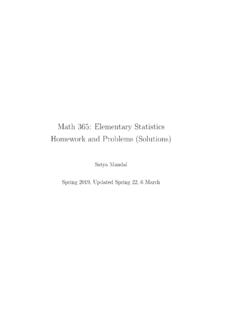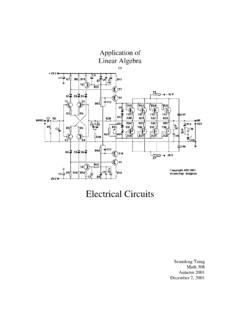Transcription of Chapter 6 Linear Transformation - University of Kansas
1 Chapter 6 Linear Intro. to Linear TransformationHomework:[Textbook, Ex. 3, 5, 9, 23, 25, 33, 37, 39 ,53, 55,57, 61(a,b), 63; page 371-].In this section,we discuss Linear 6. Linear TRANSFORMATIONR ecall, from calculus courses, a funtionf:X Yfrom a setXto a setYassociates to eachx Xa unique elementf(x) is some commonly used called the domain called the codomain Iff(x) =y,then we sayyis the image preimageofyispreimage(y) ={x X:f(x) =y}.4. The range offis the set of images of elements this section we deal with functions from a vector sapceVtoanother vector spaceW,that respect the vector space structures. Sucha function will be called a Linear Transformation , defined as two vector spaces. A functionT:V Wis called alinear transformationofVintoW,if following two prper-ties are true for allu,v Vand (u+v) =T(u)+T(v).(We say thatTpreserves additivity.) (cu) =cT(u).
2 (We say thatTpreserves scalar multiplica-tion.)Reading assignmentRead [Textbook, Examples 1-3, p. 362-].Trivial Examples:Following are two easy INTRO. TO Linear TRANSFORMATION1911. LetV, Wbe two vector spaces. DefineT:V WasT(v) =0f or allv a Linear Transformation , to be called thezero LetVbe a vector space. DefineT:V VasT(v) =vf or allv a Linear Transformation , to be called theidentitytransformation Properties of Linear transformationsTheorem two vector spaces. SupposeT:V Wis a Linear Transformation . (0) = ( v) = T(v) for allv (u v) =T(u) T(v) for allu,v Ifv=c1v1+c2v2+ +cnvnthenT(v) =T(c1v1+c2v2+ +cnvn) =c1T(v1)+c2T(v2)+ +cnT(vn). property (2) of the definition , we haveT(0) =T(00) = 0T(0) = 6. Linear TRANSFORMATIONSo, (1) is proved. Similarly,T( v) =T(( 1)v) = ( 1)T(v) = T(v).So, (2) is proved. Then, by property (1) of the definition , we haveT(u v) =T(u+ ( 1)v) =T(u) +T(( 1)v) =T(u) T(v).
3 The last equality follows from (2). So, (3) is prove (4), we use induction, 1 : we haveT(c1v1) =c1T(v1),by property (2) of the definition 2,by the two properties of definition , we haveT(c1v1+c2v2) =T(c1v1) +T(c2v2) =c1T(v1) +c2T(v2).So, (4) is prove forn= , we assume that the formula (4) is validforn 1 vectors and prove it haveT(c1v1+c2v2+ +cnvn) =T(c1v1+c2v2+ +cn 1vn 1)+T(cnvn)= (c1T(v1) +c2T(v2) + +cn 1T(vn 1)) +cnT(vn).So, the proof is Linear transformations given by matricesTheorem a matrix of sizem a vectorv= v1v2 vn Rndef ine T(v) =Av=A v1v2 vn .ThenTis a Linear Transformation INTRO. TO Linear properties of matrix multiplication, foru,v Rnandscalarcwe haveT(u+v) =A(u+v) =A(u) +A(v) =T(u) +T(v)andT(cu) =A(cu) =cAu=cT(u).The proof is (or all) of our examples of Linear transformations comefrom matrices , as in this assignmentRead [Textbook, Examples 2-10, p.]
4 365-]. Projections along a vector inRnProjections inRnis a good class of examples of Linear define projection along a the definition of orthogonal projection, in thecontextof Euclidean Rnis a vector. Then,f oru Rndef ineprojv(u) =v ukvk2v1. Thenprojv:Rn Rnis a Linear is because, for another vectorw Rnand a scalarc,it is easy to checkprojv(u+w) =projv(u)+projv(w)and projv(cu) =c(projv(u)).2. The point of such projections is that any vectoru Rncan bewritten uniquely as a sum of a vector alongvand another oneperpendicular tov:u=projv(u) + (u projv(u)).194 Chapter 6. Linear TRANSFORMATIONIt is easy to check that (u projv(u)) projv(u).Exercise (Ex. 4, p. 371)LetT(v1, v2, v3) = (2v1+v2,2v2 3v1, v1 v3)1. ComputeT( 4,5,1).Solution:T( 4,5,1) = (2 ( 4)+5,2 5 3 ( 4), 4 1) = ( 3,22, 5).2. Compute the preimage ofw= (4,1, 1).Solution:Suppose (v1, v2, v3) is in the preimage of (4,1, 1).
5 Then(2v1+v2,2v2 3v1, v1 v3) = (4,1, 1).So,2v1+v2= 42v2 3v3= 1v1 v3= 1 The augmented matrix of this system is 2 1 0 40 2 3 11 0 1 1 its Gauss Jordan f orm 1 0 1 0 0 1 So,P reimage((4,1, 1)) ={(.5714, , )}. INTRO. TO Linear TRANSFORMATION195 Exercise (Ex. 10. p. 371)Determine whether the functionT:R2 R2T(x, y) = (x2, y)is Linear ?Solution:We haveT((x, y) + (z, w)) =T(x+z, y+w) = ((x+z)2, y+w)6= (x2, y) + (z2, w) =T(x, y) +T(z, w).So,Tdoes not preserve additivity. So,Tis not ,you could check thatTdoes not preserve scalar ,you could check this failure(s), numerically. For example,T((1,1) + (2,0)) =T(3,1) = (9,1)6=T(1,1) +T(2,0).Exercise (Ex. 24, p. 371)LetT:R3 R3be a Linear trans-formation such thatT(1,0,0) = (2,4, 1), T(0,1,0) = (1,3, 2), T(0,0,1) = (0, 2,2).ComputeT( 2,4, 1).Solution:We have( 2,4, 1) = 2(1,0,0) + 4(0,1,0) (0,0,1).So,T( 2,4, 1) = 2T(1,0,0)+4T(0,1,0) T(0,0,1) = (2,4, 1)+(1,3, 2)+(0, 2,2) = (3,5, 1).
6 Linear transformationT:V Vcan be defined, simplyby assigning valuesT(vi) for any basis{v1,v2, .. ,vn} thiscase of the our problem, values were assigned for the standard basis{e1,e2,e3} 6. Linear TRANSFORMATIONE xercise (Ex. 38, p. 372)LetA=" 1 2 1 3 40 0 2 1 0#. Let T:R5 R2be the Linear transformationT(x) = ComputeT(1,0, 1,3,0).Solution:T(1,0, 1,3,0) =" 1 2 1 3 40 0 2 1 0# 10 130 ="7 5#.2. Compute preimage, underT,of ( 1,8).Solution:The preimage consists of the solutions of the linearsystem" 1 2 1 3 40 0 2 1 0# x1x2x3x4x5 =" 18#The augmented matrix of this system is" 1 2 1 3 4 10 0 2 1 0 8#.The Gauss-Jordan form is"1 2 0 4 50 0 1 .5 0 4#. INTRO. TO Linear TRANSFORMATION197We use parametersx2=t, x4=s, x5=uand the solotions aregiven byx1= 5 + 2t+ + 4u, x2=t, x3= 4 +.5s, x4=s, x5=uSo, the preimageT 1( 1,8) ={(5+2t+ +4u, t,4+.)}
7 5s, s, u) :t, s, u R}.Exercise (Ex. 54 (edited), p. 372)LetT:R2 R2be thelinear Transformation such thatT(1,1) = (0,2) andT(1, 1) = (2,0).1. ComputeT(1,4).Solution:We have to write(1,4) =a(1,1)+b(1, 1). Solving(1,4) = (1,1) (1, 1).So,T(1,4) = (1,1) (1, 1) = (0,2) (2,0) = ( 3,5).2. ComputeT( 2,1).Solution:We have to write( 2,1) =a(1,1)+b(1, 1). Solving( 2,1) = .5(1,1) (1, 1).So,T( 2,1) = .5T(1,1) (1, 1) = .5(0,2) (2,0) = ( 3, 1).Exercise (Ex. 61 (edited), p. 372)LetT:R3 R3theprojectionT(u) =projv(u) wherev= (1,1,1).198 Chapter 6. Linear TRANSFORMATION1. FindT(x, y, z).Solution:See definition (x, y, z) =v (x, y, z)kvk2v=(1,1,1) (x, y, z)k(1,1,1)k2(1,1,1) =x+y+z3(1,1,1)= x+y+z3,x+y+z3,x+y+z3 .2. ComputeT(5,0,5).Solution:We haveT(5,0,5) = x+y+z3,x+y+z3,x+y+z3 = 103,103,103 .3. Compute the matrix :The matrix is given byA= 131313131313131313 ,becauseT(x, y, z) = 131313131313131313 xyz.
8 KERNEL AND RANGE OF Linear Kernel and Range of Linear Transfor-mationWe will essentially, skip this section. Before we do that, let us give afew , Wbe two vector spaces andT:V Walinear Then the kernel ofT, denoted byker(T),is the set ofv VsuchthatT(v) = ,ker(T) ={v V:T(v) =0}.It is easy to see theker(T)is a subspace Recall, range ofT,denoted byrange(T),is given byrange(T) ={v W:w=T(v)f or somev V}.It is easy to see therange(T)is a subspace We say theTisisomorphism, ifTis one-to-one and fol-lows, thatTis an isomorphism ifker(T) ={0}andrange(T) = 6. Linear matrices for Linear TransformationsHomework:[Textbook, , Ex. 5, 7, 11, 13, 17, 19, 21, 23, 25, 29,31, 33, 35(a,b), 37(a,b), 39, 43, 45, 47; p. 397 ]Optional Homework:[Textbook, , Ex. 57, 59; p. 398]. (We willnot grade them.)In this section,to each Linear Transformation weassociate a transformations and matrices have very deep fact, study of Linear transformations can be reduced to the study ofmatrices and , we will study this relationship for lineartransformationsT:Rn Rm;and later study the same for lineartransformationsT:V Wof general vector this section, we will denote the vectors inRn,as column , written as columns, the standard basis ofRnis given byB={e1,e2.}
9 ,en} 10 0 , 01 0 , , 00 1 . Theorem :Rn Rmbe a Linear Transformation . WriteT(e1) = a11a21 am1 , T(e2) = a12a22 am2 , , T(en) = a1na2n amn . matrices FOR Linear TRANSFORMATIONS201 These columnsT(e1), T(e2).. , T(en) form am nmatrixAas follows,A= a11a12.. a1na21a22.. a2n am1am2.. amn .This matrixAhas the property thatT(v) =Avf or allv matrixAis called thestandard can writev Rnasv= v1v2 vn =v1e1+v2e2+ + have,Av= a11a12.. a1na21a22.. a2n am1am2.. amn v1v2 vn =v1 a11a21 am1 +v2 a12a22 am2 + +vn a1na2n amn =v1T(e1)+v2T(e2)+ +vnT(en) =T(v1e1+v2e2+ +vnen) =T(v).The proof is assignment:Read [Textbook, Examples 1,2; page 389-390].In our context of Linear transformations, we recall the followingdefinition of composition of :Rn Rm, T2:Rm Rp202 Chapter 6. Linear TRANSFORMATIONbe two Linear transformations. Define thecompositionT:Rn RpofT1withT2asT(v) =T2(T1(v))f orv compositionTis denoted byT= ,RnT=T2oT1""DDDDDDDDT1//RmT2 :Rn Rm, T2:Rm Rpare two Linear Then, the compositionT=T2oT1:Rn Rpis a Linear SupposeA1is the standard matrix ofT1andA2is the standardmatrix , the standard matrix of the compositionT=T2oT1is the product A= ,v Rnand scalarsc,we haveT(u+v) =T2(T1(u+v)) =T2(T1(u)+T1v)) =T2(T1(u))+T2T1(v)) =T(u)+T(v)andT(cu) =T2(T1(cu)) =T2(cT1(u)) =cT2(T1(u)) =cT(u).
10 So,Tpreserves addition and scalar multiplication. ThereforeTis alinear Transformation and (1) is proved. To prove (2), we haveT(u) =T2(T1(u)) =T2(A1u) =A2(A1u) = (A2A1) matrices FOR Linear TRANSFORMATIONS203 ThereforeT(e1) is the first column ofA2A1, T(e2) is the second columnofA2A1,and so on. Therefore, the standard matrix is assignment:Read [Textbook, Examples 3; page 392].Definition :Rn Rn, T2:Rn Rnbe two Linear transformations such that for everyv Rnwe haveT2(T1(v)) =vand T1(T2(v)) =v,then we say thatT2is theinverseofT1,and we say an inverseT2ofT1is unique and is denoted byT 11.( (Rn)denote the set of all Linear transformationsT:Rn (Rn)has a binary operation by identity operationI:Rn Rnacts as the identitiy under thiscomposition operation. The definition of inverse ofT1above, just cor-responds to the inverse under this composition operation.)Theorem :Rn Rnbe a Linear transformations and letAbe the standard matrix , the following are equivalent, an , ifTis invertible, then the standard matrix ofT 1isA 6.






